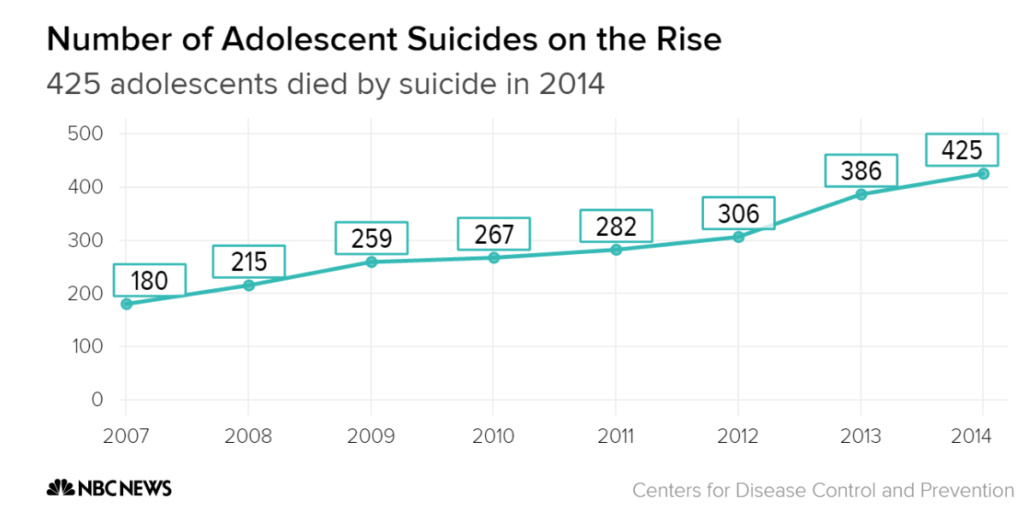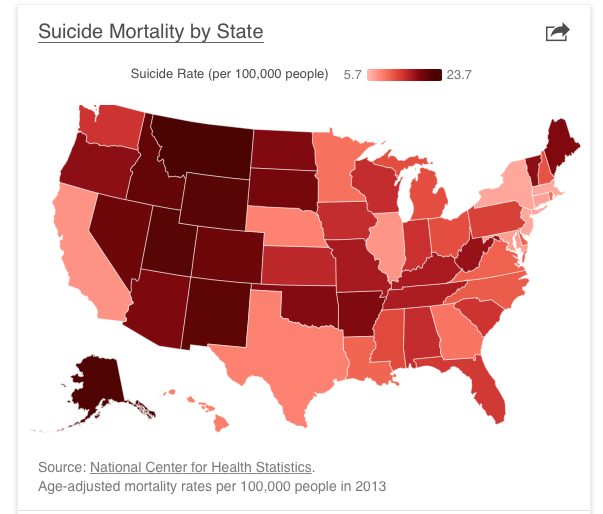Teen Suicide
An article written by NBC News about a 14 year old boy who took his own life is very telling about the rise in teen suicide. Connor Ball, a 14 year old, died by suicide in October of 2011.
According to the Centers for Disease Control and Prevention, teen suicide has more than doubled since 2007. In 2014, 425 kids between the ages of 10-14 took their own life.
(Graph created by NBC News)
Also according to the CDC, suicide deaths among teens has surpassed the number of motor vehicle deaths of teens. The article states:
“…the spike in youth suicides is alarming — especially when compared to the number of deaths from car accidents. In 1999, the CDC found that the mortality rate of children between the ages of 10 and 14 who died in car crashes was about four times higher than the rate of death by suicide. Over the next 15 years, the death rate for car accidents declined 58 percent, while the death rate for suicide fluctuated and then doubled between 2007 and 2014.”
Even more sobering is this chart of the United States showing the suicide mortality rate per 100,000 people state-by-state.
These statistics are sobering and emphasize the importance of trying to recognize some of the symptoms and signs in teens who may be considering suicide.
Some of those symptoms include:
- Talking about suicide – saying “I’m going to kill myself,” “I wish I was dead” or “I wish I hadn’t been born”
- Acquiring the means to commit suicide, such as buying a gun or rope or pills
- Withdrawal and wanting to be left alone
- Mood swings, such as a sudden improvement or decline
- Preoccupation with death, dying or violence
- Hopelessness or feeling trapped
- Increased use of alcohol or drugs
- Depression
- Change in normal routine, including eating or sleeping patterns
- Doing risky or self-destructive things
- Giving away belongings or getting affairs in order
- Extreme anxiety
- Loss of interest in activities they previously enjoyed
- Visiting people as if saying ‘goodbye’
It’s hard to pinpoint what is causing the rise in suicide rates. There are a variety of factors that can contribute to suicidal ideations and attempts. Some of which are depression, substance abuse, bullying, and an increase in divorce rates which is splitting families apart. Another suspected cause in the rise of teen suicide rates is social media and cyber bullying. Bullying used to occur most often during school hours, but now it can happen 24 hours a day, 7 days a week. There is often no escape.
These statistics also emphasize the importance of suicide prevention education.
“Motor vehicle prevention safety is ten times what we spend on suicide prevention,” said Draper of the National Suicide Prevention Lifeline. “We refer to the reduction in motor vehicle accident deaths as the public health achievement of the 20th century. If we can make a similar kind of investment in protecting families from suicide, it can be the great public health achievement of the 21st century.”
Suicide prevention is needed now more than ever. Knowing and recognizing the warning signs of suicidal thoughts is crucial for every parent. And if there is ANY part of you that suspects your teen may be struggling with depression, substance abuse, bullying or any other factors that could lead to suicidal thoughts and actions, get help. Immediately.














